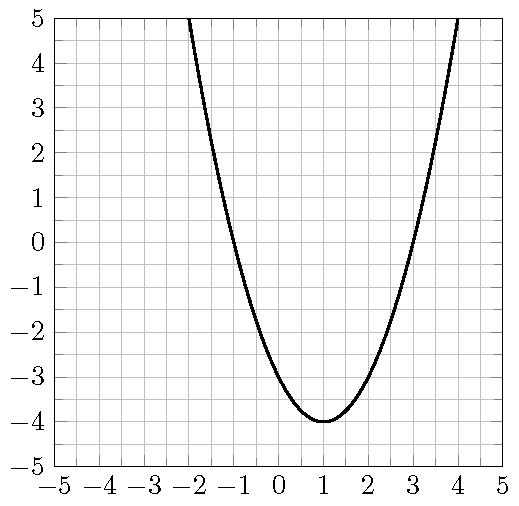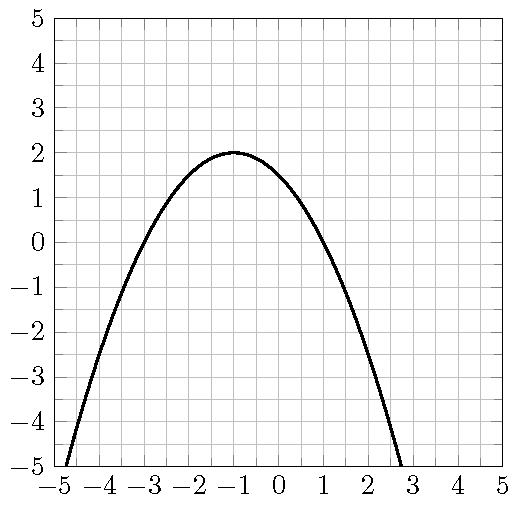Topic 13 Quadratic Functions
13.1 Maximize the Revenue
When price increases, demand decreases and vice verse. A retail store found that the price as a function of the demand for a certain product is . The revenue of selling units is . To maximize the revenue, what should be the price?
13.2 The Graph of a Quadratic Function
The graph of a quadratic function , , is called a parabola.
By completing the square, a quadratic function can always be written in the form , where and .
- The line is called the axis of symmetry of the parabola.
- The point is called the vertex of the parabola.
13.3 The Minimum or Maximum of a Quadratic Function
Consider the quadratic function , .
- If , then the parabola opens upward and has a minimum at the vertex.
- If , then the parabola opens downward and has a maximum at the vertex.
13.4 Intercepts of a Quadratic Function
Consider the quadratic function , .
- The -intercept is .
- The -intercepts, if exist, are the solutions of the equation .
Example 13.1 Find the axis of symmetry and the vertex of the quadratic function .
- Solution.
The coefficients are , and . Then the axis of symmetry is
The vertex is given by
Example 13.2 Find the axis of symmetry and the vertex of the quadratic function .
- Solution.
The equation is in the perfect square form . In this case, and . Then the axis of symmetry is
The vertex is given by
Example 13.3 Sketch the graph of the quadratic function .
- Solution.
The line of symmetry is
The vertex is
Since and , the parabola is above the -axis and there is no -intercept.
The -intercept is
To have a better graph, find an additional point on it, say
Using the above information to sketch the graph.

Example 13.4 Does the function have a maximum or minimum? Find it.
Solution.
- Since , the function opens upward and has a minimum.
- Find the line of symmetry : .
- Find the minimum by plugging into the function . The minimum is
Example 13.5 Consider the function . Find values of such that .
Solution.
- Set up the equation for .
- Solve the equation , we get or . The values of such that are and .
Example 13.6 A quadratic function whose the vertex is has a -intercept . Find the equation that defines the function.
Solution.
- Write down the general form of using only the vertex. Quadratic functions with the vertex at are defined by , where is a nonzero real number.
- Determine the unknown using the remaining information. Since is on the graph of the function, the number must satisfy the equation .
- Solving for from the equation, we get . The quadratic function is given by .
13.5 Practice
Problem 13.1 Sketch the graph of the quadratic functions and find
- the coordinates of the -intercepts,
- the coordinates of the -intercept,
- the equation of the axis of symmetry,
- the coordinates of the vertex.
- the interval of values such that .
Problem 13.2 Sketch the graph of the quadratic functions and find
- the coordinates of the -intercepts,
- the coordinates of the -intercept,
- the equation of the axis of symmetry,
- the coordinates of the vertex.
- the interval of values such that .
Problem 13.3 Consider the parabola in the graph.
- Determine the coordinates of the -intercepts.
- Determine the coordinates of the -intercept.
- Determine the coordinates of the vertex.
- For what values of is .
- Find an equation for the function.

Problem 13.4 Consider the graph of the function shown in the picture.
- Determine the coordinates of the -intercepts.
- Determine the coordinates of the -intercept.
- Determine the coordinates of the vertex.
- Find the domain of the function.
- Find the range of the function.
- For what values of is .
- Over which interval is the function positive.
- Over which interval is the function decreasing.
- Find an additional point on the graph.
- Find an equation for the function.

:::{.exercise}
Consider the quadratic functions and find the following values or intervals
- the coordinates of all intercepts
- the coordinates of the vertex
- the equation and graph of the axis of symmetry
- the domain and range in interval notation
- the coordinates of an additional point on the graph
- the maximum or minimum value
- the value at which the max or min is reached
- the interval over which the function is negative
- the interval over which the function is positive
- the interval over which the function is increasing.
Problem 13.5 A store owner estimates that by charging dollars each for a certain cell phone case, he can sell phone cases each week. The revenue in dollars is when the selling price of a computer is , Find the selling price that will maximize revenue, and then find the amount of the maximum revenue.
Problem 13.6 A ball is thrown upwards from a rooftop. It will reach a maximum vertical height and then fall back to the ground. The height of the ball from the ground after time seconds is feet.
- When will the toy rocket reach its maximum height? What will be the maximum height?
- When will the toy rocket hit the ground?
- How high above the ground will the toy rocket be after 2 seconds.
- When will the toy rocket be 96 feet above the ground?
Problem 13.7 A ball is thrown upward from the ground with an initial velocity ft/sec. The height of the ball after seconds is . The ball hits the ground after 4 seconds. Find the maximum height and how long it will take the ball to reach the maximum height.
Problem 13.8 A toy factory estimates that the demand of a particular toy is units each week if the price is $ dollars per unit. Each week there is a fixed cost $40,000 to produce the demanded toys. The weekly revenue is a function of the price given by
- Find the function that models the weekly revenue, , received when the selling price is $ per unit.
- What the price range so the the revenue is nonnegative.